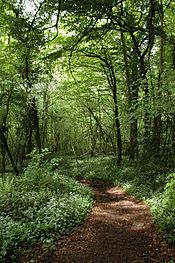Lippets Grove facts for kids
Quick facts for kids Lippets Grove |
|
|---|---|

Footpath near Lippets Grove
|
|
| Lua error in Module:Location_map at line 420: attempt to index field 'wikibase' (a nil value). | |
| Type | Gloucestershire Wildlife Trust reserve |
| Location | Wye Valley AONB, near Brockweir |
| Area | 12.3 acres (5.0 ha) |
| Created | 1987 |
| Operated by | Gloucestershire Wildlife Trust Forestry Commission |
| Status | Open all year |
Lippets Grove is a special nature reserve in Gloucestershire, England. It covers about 5 hectares, which is like 12 football fields! This amazing place has been looked after by the Gloucestershire Wildlife Trust since 1987. They leased it from the Forestry Commission. Lippets Grove is so important for wildlife that it's listed as a 'Key Wildlife Site' (KWS). This means it's a really valuable spot for plants and animals.
Contents
Where is Lippets Grove?
Lippets Grove is in a beautiful area called the Wye Valley Area of Outstanding Natural Beauty. This means it's a protected landscape because of its special beauty. You can find it about half a mile south of a village called Brockweir.
The reserve is next to another important nature spot, the Shorn Cliff And Caswell Woods Site of Special Scientific Interest (SSSI). An SSSI is a place protected by law because it has rare wildlife or geology. Lippets Grove is part of a huge area of very old woodland.
You can easily reach the reserve by walking along the Offa's Dyke Path. This famous walking trail goes right past the northern and western edges of Lippets Grove. The ground here is mostly flat and made of a type of rock called limestone.
The Amazing Martagon Lily
Lippets Grove is super famous for one plant in particular: the Martagon Lily. This beautiful flower is quite rare in Gloucestershire, but it grows all over Lippets Grove! It's a "naturalised" plant, which means it wasn't originally from here but has been growing wild for a long time. Experts say this is the best place in the whole county to see the Martagon Lily.
Plants You Can Find
In spring, Lippets Grove bursts with life! You can see many lovely wildflowers, including:
- Wood Anemone
- Cuckooflower
- Bluebell
- Ramsons (also known as wild garlic)
- Herb-Paris
- Toothwort, which is a unique plant that gets its food from the roots of hazel trees.
How the Woodland is Managed
In 1966, the Forestry Commission planted new trees in Lippets Grove. Before that, like many woods in the Wye Valley, it was managed by "coppicing." This is a way of cutting trees down to the base so they regrow, providing wood for people.
The trees planted in 1966 were mostly Beech and Corsican Pine. Over time, some of these trees have naturally died off. This has allowed other native trees to grow, such as:
- Ash
- Wild Cherry
- Silver Birch
- Sycamore
Some of these new trees have also grown back from old coppice stumps. The woodland also has a good mix of shrubs growing underneath the taller trees. These include Goat Willow, Elder, and Hazel. You might also spot Traveller's-joy, a climbing plant.
Protecting the Martagon Lily
Looking after the Martagon Lily is a big part of the conservation work at Lippets Grove. At first, people thought that having a tall, dense forest canopy and not much scrub (bushes) was best for the lilies.
Now, the people managing the reserve are working to clear out some of the crowded Corsican pines. This helps the older coppice areas grow back and gives the lilies more space and light.
Even with careful management, the Martagon Lily faces some challenges. The Lily Beetle and hungry Fallow Deer can eat the plants. But even with these challenges, lots of Martagon Lilies still thrive in Lippets Grove!
Walking Trails Nearby
If you love walking, there's a special guide that tells you all about walks in the Wye Valley. It helps you find wildlife and amazing views. This guide includes information about:
- The Offa's Dyke Path
- The Gloucestershire Way
- Places like Devil's Pulpit (Tintern)
- Lippets Grove itself
- Passage Grove
- Caswell Woods SSSI
- Oakhill Wood
- East Wood nature reserve
- Ridley Bottom nature reserve
- And Poor's Allotment SSSI
All these places offer great opportunities to explore nature!

